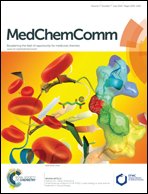Cellular imaging and mitochondria targeted photo-cytotoxicity in visible light by singlet oxygen using a BODIPY-appended oxovanadium(iv) DNA crosslinking agent†‡
Abstract
Oxovanadium(IV) complexes [VO(L1)Cl2] (1) and [VO(L2)Cl2] (2), where L1 is N,N,N-donor benzyldipicolylamine and L2 is the BODIPY-appended N,N,N-donor base, viz., (8-{[bis(2-pyridylmethyl)amino]methylphenyl}-4,4-difluoro-1,3,5,7-tetramethyl-4-bora-3a,4a-diaza-s-indacene), were synthesized, characterized and their photo-induced DNA crosslinking activity and photocytotoxicity were studied. Single crystal X-ray diffraction analysis of 1 reveals two chloride ligands in the cis disposition to the VO2+ moiety. The complexes are 1 : 1 electrolytes in aqueous media, and the loss of the second chloride takes place on irradiation with visible light. The DNA melting and alkaline agarose gel electrophoresis studies on complex 2, treated with ct-DNA in light, suggest the formation of DNA crosslinks. Complex 2 selectively localizes in the mitochondria of the HeLa and MCF-7 cancer cells and shows remarkable photocytotoxicity via an apoptotic pathway (IC50 < 3 μM) in visible light (400–700 nm) with low dark toxicity. The complex is remarkable in showing dual activity: (i) light-activated VO2+–DNA crosslink formation and (ii) singlet oxygen (1O2) induced mitochondria-targeted PDT involving the BODIPY moiety.


 Please wait while we load your content...
Please wait while we load your content...